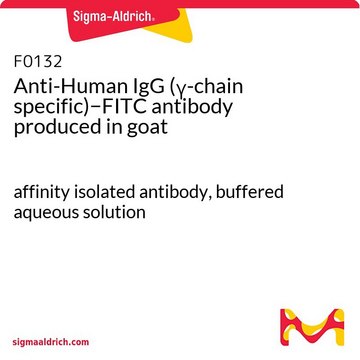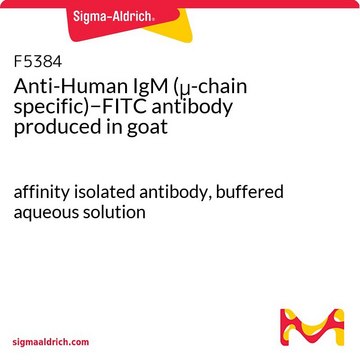F6380
Anti-Human IgG (γ-chain specific)−FITC antibody produced in goat
IgG fraction of antiserum, buffered aqueous solution
Iniciar sesiónpara Ver la Fijación de precios por contrato y de la organización
About This Item
Productos recomendados
origen biológico
goat
conjugado
FITC conjugate
forma del anticuerpo
IgG fraction of antiserum
tipo de anticuerpo
secondary antibodies
clon
polyclonal
Formulario
buffered aqueous solution
técnicas
direct immunofluorescence: 1:32
temp. de almacenamiento
2-8°C
modificación del objetivo postraduccional
unmodified
¿Está buscando productos similares? Visita Guía de comparación de productos
Descripción general
IgG antibody subtype is the most abundant serum immunoglobulins of the immune system. It is secreted by B cells and is found in blood and extracellular fluids and provides protection from infections caused by bacteria, fungi and viruses. Maternal IgG is transferred to fetus through the placenta that is vital for immune defence of the neonate against infections
Anti-Human IgG (γ-chain specific)-FITC antibody is specific for human IgG subclasses. Whole antiserum is fractionated and then further purified by ion exchange chromatography to provide the IgG fraction of antiserum. Goat anti-human IgG is conjugated to Sigma Fluorescein Isothiocyanate (FITC).
Anti-Human IgG (γ-chain specific)-FITC antibody is specific for human IgG subclasses. Whole antiserum is fractionated and then further purified by ion exchange chromatography to provide the IgG fraction of antiserum. Goat anti-human IgG is conjugated to Sigma Fluorescein Isothiocyanate (FITC).
Inmunógeno
Pooled normal human serum
Aplicación
Anti-Human IgG (γ-chain specific)-FITC antibodymay be used for immunofluorescent labelling of human peripheral blood lymphocytes at a working antibody dilution of 1:32 or 1:130. was used to determine IgG isotypes on human RBC by exhaustive photon reassignment microscopy.
Forma física
Solution in 0.01 M phosphate buffered saline, pH 7.4, containing 15 mM sodium azide as preservative
Cláusula de descargo de responsabilidad
Unless otherwise stated in our catalog or other company documentation accompanying the product(s), our products are intended for research use only and are not to be used for any other purpose, which includes but is not limited to, unauthorized commercial uses, in vitro diagnostic uses, ex vivo or in vivo therapeutic uses or any type of consumption or application to humans or animals.
¿No encuentra el producto adecuado?
Pruebe nuestro Herramienta de selección de productos.
Código de clase de almacenamiento
10 - Combustible liquids
Punto de inflamabilidad (°F)
Not applicable
Punto de inflamabilidad (°C)
Not applicable
Elija entre una de las versiones más recientes:
¿Ya tiene este producto?
Encuentre la documentación para los productos que ha comprado recientemente en la Biblioteca de documentos.
U Specks et al.
Clinical and experimental immunology, 109(2), 286-295 (1997-08-01)
We have expressed conformationally intact, enzymatically active recombinant PR3 in HMC-1 cells (HMC-1/PR3 cells) that is recognized by C-ANCA. Here we directly compared the clinical utility of C-ANCA testing by indirect immunofluorescence (IIF) using HMC-1/PR3 cell cytospin versus polymorphonuclear neutrophil
B Pouvelle et al.
Nature medicine, 6(11), 1264-1268 (2000-11-04)
A common pathological characteristic of Plasmodium falciparum infection is the cytoadhesion of mature-stage-infected erythrocytes (IE) to host endothelium and syncytiotrophoblasts. Massive accumulation of IE in the brain microvasculature or placenta is strongly correlated with severe forms of malaria. Extensive binding
Ingrid J G Burvenich et al.
mAbs, 8(4), 775-786 (2016-04-01)
IgG has a long half-life through engagement of its Fc region with the neonatal Fc receptor (FcRn). The FcRn binding site on IgG1 has been shown to contain I253 and H310 in the CH2 domain and H435 in the CH3
J Gysin et al.
Infection and immunity, 67(12), 6596-6602 (1999-11-24)
We performed ex vivo experiments with Plasmodium falciparum-infected human placentas from primi- and multigravida women from Cameroon. All women, independent of their gravida status, had anti-chondroitin sulfate A (CSA) adhesion antibodies which cross-reacted with heterologous strains, such as FCR3 and
Irina B Torres et al.
Clinical transplantation, 28(10), 1148-1154 (2014-08-12)
Transplant glomerulopathy (TG) is the characteristic lesion of chronic antibody-mediated rejection (AMR). However, in some patients presents with no circulating HLA antibodies or C4d positivity. Patients with TG accomplishing criteria for chronic AMR were compared to patients with isolated TG.
Nuestro equipo de científicos tiene experiencia en todas las áreas de investigación: Ciencias de la vida, Ciencia de los materiales, Síntesis química, Cromatografía, Analítica y muchas otras.
Póngase en contacto con el Servicio técnico








